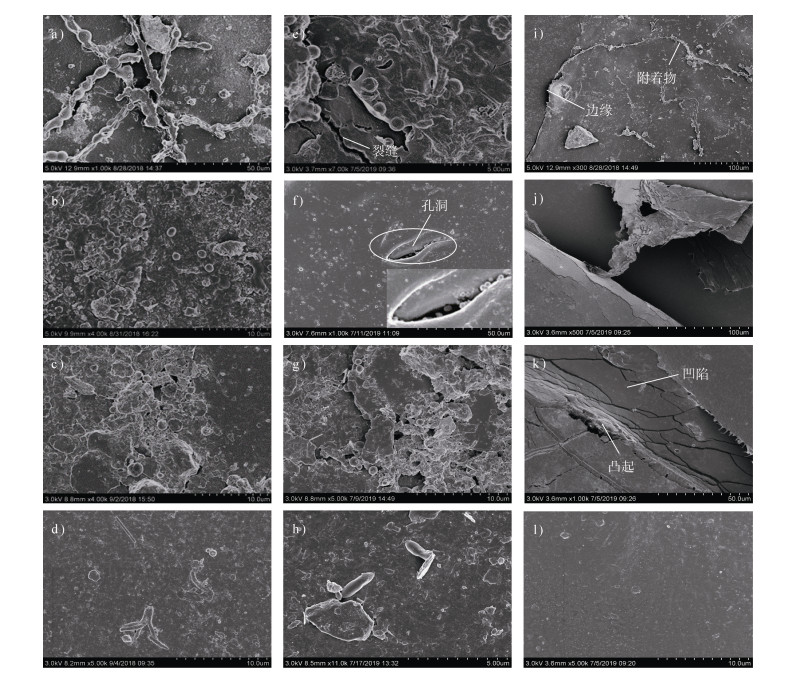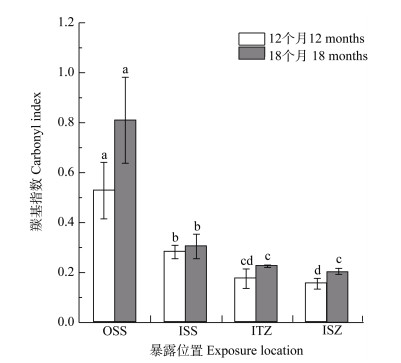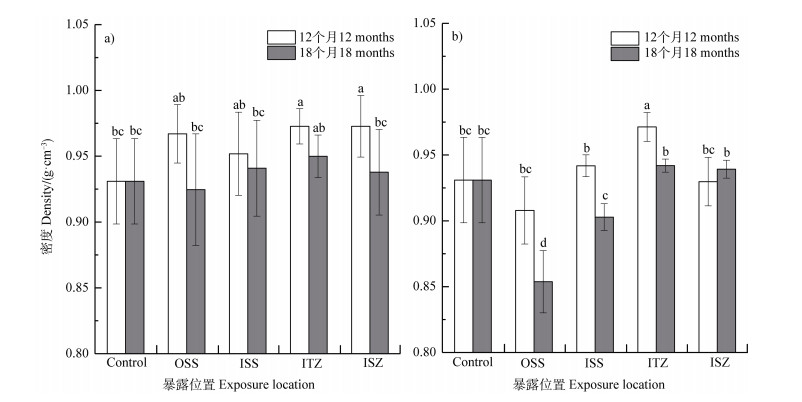2. 中国科学院海岸带环境过程与生态修复重点实验室(烟台海岸带研究所), 山东烟台 264003;
3. 中国科学院大学, 北京 100049;
4. 浙江工业大学环境学院, 杭州 310014;
5. 中国科学院土壤环境与污染修复重点实验室(南京土壤研究所), 南京 210008
2. CAS Key Laboratory of Coastal Environmental Processes and Ecological Remediation, Yantai Institute of Coastal Zone Research, Chinese Academy of Sciences, Yantai, Shandong 264003, China;
3. University of Chinese Academy of Sciences, Beijing 100049, China;
4. College of Environment, Zhejiang University of Technology, Hangzhou 310014, China;
5. CAS Key Laboratory of Soil Environment and Pollution Remediation, Institute of Soil Science, Chinese Academy of Sciences, Nanjing 210008, China
近年来,微塑料污染已演变为全球性环境问题,并被第二届联合国环境大会列为环境与生态科学研究领域的第二大科学问题。据估计,全球环境中共累积约49亿吨塑料废弃物[1]。进入环境中的塑料会在光照、生物降解等物化和生物共同作用下碎化为更小的颗粒或碎片,其中粒径 < 5 mm的微塑料可能是数量最多的塑料碎片[2]。
光氧化会引起微塑料的非生物降解[3],也是导致微塑料在降解初期C-C骨架断裂的主要因素[4]。此外,环境中的微塑料表面会被微生物定殖并形成生物膜,生物膜中的部分微生物对微塑料也具有一定的生物降解作用[5]。环境中的微塑料在生物与非生物因素的长期作用下会发生理化性质(包括形貌、化学组成、密度、粗糙度等)变化[6-7],导致微塑料发生风化。风化可引起微塑料表面特性的改变,使其产生裂缝及破碎[8-9]、颜色加深[9]、拉伸强度下降[10]、结晶度改变[11]等。此外,风化增加了微塑料上包括羟基、羰基等在内的含氧官能团的量[2],诱导聚合物链断裂和氧化,密度(摩尔质量)降低[8,12],并通过含氧官能团和产生粗糙的表面来降低微塑料的疏水性[2]。总之,风化可引起环境中微塑料的理化性质改变,使其与原始塑料的性质相比发生极大变化,但由此引起的微塑料环境归趋和潜在环境效应尚不清楚。目前,已有一些学者在实验室内开展了塑料老化的模拟试验研究,如Paluselli等[13]在实验室中使用天然海水对聚氯乙烯(Polyvinyl chloride,PVC)进行孵育研究,发现有光照和细菌暴露的PVC释放的邻苯二甲酸酯(Phthalate,PAE)总量增加了多达5倍。此外,也有部分学者研究了真实环境微塑料样品的风化特征,Veerasingam等[14]发现在河口及附近潮滩沉积物中的树脂颗粒表面受到侵蚀和磨损,且表面存在焦油和动植物残体等附着物,并出现了酯基和酮基,认为这可能是生物和光氧化作用共同导致。周倩等[15]采用质谱鉴定了黄渤海沿岸河口潮滩中多种微塑料风化后所产生的特有含氧、含氮化学物质,认为环境微塑料在风化的过程中除了发生形貌的变化,还发生了成分的变化。海岸带是陆海交界地带,受到人类活动和洋流、潮汐的交互作用,容易成为塑料垃圾的汇集区[16]。国内外已有许多针对海岸带区域的微塑料污染研究[17-19]。但目前尚缺乏真实河口海岸环境中微塑料的长期风化特征研究,对于海岸环境中不同潮带微塑料的长期风化特征及其潜在环境效应更是鲜有报道。
黄河三角洲的河口区是受气候变化和人类活动交互作用强烈影响的区域[20],也是盐度、水分、有机碳等环境因子在海岸带陆海梯度条件下显著变化的区域[21-22]。研究微塑料在黄河口不同海岸环境中的长期风化特征对于揭示微塑料的环境效应与归趋具有重要意义。本研究以黄渤海海岸环境中常见的低密度聚乙烯(Low density polyethylene,LDPE)薄膜[23]为目标微塑料,通过长达18个月的野外暴露试验,研究其在黄河口海岸带潮上带、潮间带以及潮下带等不同海岸环境中的长期风化特征,以期为阐明海岸带环境中微塑料的环境归趋与环境效应提供科学依据。
1 材料与方法 1.1 试验设计将0.2 g供试微塑料(LDPE薄膜,5 mm× 5 mm)放入尼龙网兜(孔径:0.15 mm,尺寸:11 cm× 10 cm)中,并固定于不锈钢框内,分别暴露于黄河口的潮上带、潮间带及潮下带等不同区域。潮上带位于中国科学院黄河三角洲滨海湿地生态试验站内(37°45'44"N,118°58'47"E),潮间带(37°47'36"N,119°9'38"E)和潮下带(37°48'21"N,119°9'47"E)位于山东省黄河三角洲国家级自然保护区内。潮上带样品分为地上部空气暴露和地下部土壤掩埋两种暴露方式,潮间带和潮下带样品均掩埋于沉积物中,即共有潮上带地上部(On the surface of the supratidal zone,OSS)、潮上带地下部(In the soil of the supratidal zone,ISS)、潮间带(In the intertidal zone,ITZ)和潮下带(In the subtidal zone,ISZ)等4个暴露位置。LDPE薄膜微塑料的野外暴露试验开始于2017年6月,并分别在暴露12个月和18个月后进行采集,将原位采集的微塑料样品置于冰盒中,快速送回实验室进行微观形貌、化学官能团和密度等理化性质的分析。
1.2 LDPE薄膜微塑料及表面附着物的微观形貌观测扫描电子显微镜(Scanning electron microscope,SEM)是研究微塑料及其表面生物膜微观形貌的重要技术之一。参考陈涛[24]的方法,分别用灭菌海水(潮间带和潮下带样品)和灭菌超纯水(18.2 MΩ)(潮上带样品)清洗薄膜微塑料表面3次,然后将微塑料置于2.5%戊二醛固定液中室温固定2 h,再使用0.1 mol·L–1的磷酸盐缓冲溶液清洗2次,并在10%、30%、50%、70%、90%的乙醇溶液中梯度脱水10 min,最后于100%乙醇中脱水两次,每次15 min,脱水后的微塑料于室温风干,表面喷金处理后放入SEM(S-4800,Hitachi,日本)真空腔内,对微塑料及表面附着物的微观形貌进行观察和拍照,并根据微生物的形貌进行形态学分类。
1.3 LDPE薄膜微塑料红外光谱定量分析塑料的老化(风化)可引起塑料表面官能团的变化,并可通过红外光谱进行定性与定量分析。本研究使用超纯水(18.2 MΩ)将薄膜微塑料超声清洗30 min并室温风干,参考Zhou等[23]的方法,通过衰减全反射傅立叶变换红外光谱仪(Nicolet iS5,Thermo Fisher,美国)收集薄膜微塑料红外吸收光谱,红外光谱波数范围为650~4 000 cm–1,分辨率4 cm–1,每次分析扫描32次。使用Omnic 32(Thermo Nicolet,美国)软件进行数据定量分析。羰基指数是常见的塑料老化定量分析指标之一,其计算方法为塑料表面官能团的红外吸收图谱中羰基峰(波数1 715 cm–1)与亚甲基峰(波数1 465 cm–1)的峰面积比值[25-26]。
1.4 LDPE薄膜微塑料密度测定LDPE薄膜微塑料的密度测定采用比重瓶法[27]。用超纯水(18.2 MΩ)分别对微塑料进行表面清洗(3次)和超声清洗(30 min),以分别去除微塑料表面松散附着物和生物膜,将微塑料室温风干。然后配制体积比为160:40、120:80、100:100、80:120、40:160的酒精-水溶液,将微塑料依次放入上述溶液中,同时以购买的新鲜塑料作为空白处理(Control),观察微塑料在梯度溶液中的沉降状态。配制微塑料沉降状态发生变化的相邻梯度溶液中的一种,向溶液中加水或酒精,直至微塑料在溶液中呈悬浮状态。取出微塑料,使用比重瓶测定溶液密度,即为微塑料的密度:
| $ 溶液浓度=\frac{\left(装满待测溶液的比重瓶质量-空比重瓶质量\right)\times 去离子水密度}{装满去离子水的比重瓶质量-空比重瓶质量}$ |
使用OriginPro 2017和SPSS 19进行数据处理与显著性差异分析。处理间差异采用Duncan多重比较法[28],图表中误差值为标准差(n = 3)。
2 结果与讨论 2.1 LDPE薄膜微塑料与表面附着物的微观形貌通过SEM对不同空间和时间的薄膜微塑料样品及购买的商品塑料进行微形貌观察。可以看出,所有野外暴露的薄膜微塑料表面均呈现一定程度的风化痕迹(图 1)。在空间尺度上,潮上带地上部暴露的微塑料表面裂化程度高于其他暴露位置的微塑料,并在整体上呈现出从潮上带至潮下带递减的趋势。其中,潮上带地上部暴露的微塑料表面裂缝最明显,宽度可达0.2 μm(图 1e)。从时间尺度来看,与暴露12个月(图 1i)相比,潮上带地上部微塑料在18个月时出现了更严重的破碎现象,在其边缘产生了亚毫米级的不规则碎屑,并有从薄膜主体上剥落的趋势(图 1j),而其余暴露位置微塑料的微观形貌在18个月时未观察到显著变化。从局部形貌来看,商品塑料(图 1l)表面较为光滑,野外暴露的微塑料表面则出现边缘粗糙、凹陷、凸起、孔洞、裂缝(图 1e、图 1f、图 1i、图 1k)等风化或老化特征,微塑料表面还普遍有物质附着(图 1i)。LDPE薄膜微塑料表面复杂的形貌特征可能是由光照、机械摩擦、化学氧化、生物降解等物理、化学或生物作用造成的[15]。潮上带地上部微塑料表面形貌出现显著变化,可能是因为受到更多的光照与机械摩擦作用。这些表面形貌特征会增加微塑料比表面积,提高微塑料对重金属等污染物的吸附能力[29]。

|
注:a)、b)、c)、d)分别为暴露12个月的潮上带地上部、地下部、潮间带及潮下带处理LDPE薄膜微塑料及其表面部分微生物形貌,e)、f)、g)、h)分别为暴露18个月的潮上带地上部、地下部、潮间带及潮下带处理LDPE薄膜微塑料及其表面部分微生物形貌,i)、j)、k)为野外暴露的LDPE薄膜微塑料局部表面形貌,l)为商品LDPE薄膜表面形貌。 Note:a), b), c)and d)image of microbes on the surface of the microplastics of LDPE film exposed for 12 months on the surface of the supratidal zone, in the soil of the supratidal zone, in the intertidal zone and in the subtidal zone, respectively; e), f), g)and h)image of microbes on the surface of the microplastics of LDPE film exposed for 18 months on the surface of the supratidal zone, in the soil of the supratidal zone, in the intertidal zone and in the subtidal zone, respectively; i), j)and k)images of the surfaces of parts of the microplastics exposed in the coastal environment; l)image of the surface of the commercial LDPE film. 图 1 LDPE薄膜微塑料及其表面附着物微观形貌 Fig. 1 Morphologies of the microplastics of LDPE film and attachment on its surface |
野外暴露的LDPE薄膜微塑料除了表面形貌发生变化,还有微生物在其表面附着定殖(图 1a—图 1h)。从薄膜微塑料表面主要微生物形态(表 1)看,球菌出现在所有野外暴露处理的薄膜表面,大多数薄膜表面还有杆菌和弧菌存在。这些物种可能是海岸带环境中稳定存在的微生物,并容易在LDPE薄膜表面定殖。薄膜微塑料表面微生物形态在暴露位置和暴露时间上还存在着一定程度的变化。总之,掩埋在海岸带不同区域的薄膜微塑料样品表面的微生物物种与掩埋点的位置密切相关,可能受到盐度和营养条件等环境因素的影响[30]。
|
|
表 1 LDPE薄膜微塑料表面主要微生物形态 Table 1 Morphology of the dominating microbes attached on the surface of the LDPE microplastics |
由图 2可知,在暴露12个月和18个月后,潮上带地上部处理的羰基指数最高。对于掩埋暴露的LDPE薄膜微塑料而言,羰基指数呈潮上带、潮间带、潮下带依次递减的规律。从暴露时间看,薄膜微塑料的羰基指数在暴露18个月时均较12个月时有所增加,其中潮下带薄膜微塑料的增加最为显著。潮上带地上部薄膜微塑料的羰基指数最高,这可能是由于充足的光照和紫外辐射作用引发薄膜微塑料的光氧化降解。Andrady[3]发现塑料的降解主要是通过太阳紫外辐射引起的光氧化反应发生的,且在海洋表面和海滩的光环境中降解最严重,在水柱的光照区以下,尤其是在海底,塑料降解则非常缓慢。本研究中野外回收的潮上带地上部薄膜微塑料已变硬变脆,有明显的老化迹象。在暴露18个月后,回收的地上部薄膜微塑料已开始粉碎破裂,由此产生粒径更小的塑料碎屑。这将导致微塑料的比表面积增加,进而提高其作为载体吸附环境中毒害污染物的能力,增加对土壤生态系统的环境风险[31]。另一方面,细小的微塑料可沿着土壤孔隙进行垂直迁移[32],与土壤颗粒缠结形成团块进而造成土壤板结[33];甚至还可与其所携带的污染物发生垂向共迁移,进而引起土壤和地下水环境的污染。

|
注:OSS,潮上带地上部;ISS,潮上带地下部;ITZ,潮间带;ISZ,潮下带。同一暴露时间无相同字母表示处理间差异显著(P < 0.05)。下同。 Note:OSS, On the surface of the supratidal zone; ISS, In the soil of the supratidal zone; ITZ, In the intertidal zone; ISZ, In the subtidal zone.Absence of the same letter means significant difference between treatments the same in duration of exposure(P < 0.05). The same below. 图 2 LDPE薄膜微塑料表面红外光谱的羰基指数 Fig. 2 Carbonyl index of the LDPE microplastics obtained via infrared spectrum |
微塑料密度变化会改变其在水体中的环境行为与归趋[7,34],对海岸环境中微塑料密度变化的研究具有重要的环境意义。与新鲜塑料相比,环境中的LDPE薄膜微塑料在暴露12个月后,各位置的微塑料密度均出现增长,在暴露18个月后,微塑料密度相比12个月时有所下降(图 3a)。12个月的微塑料密度大,可能是因为在其野外暴露初期,表面生物膜的形成而引起微塑料的复合密度增加。但随着暴露时间增加,在生物和非生物因素的共同作用下,微塑料发生风化,出现聚合物链断裂[10],从而导致密度降低,这也与薄膜微塑料羰基指数在暴露18个月时出现增加的趋势一致。

|
图 3 超声清洗前(a)、后(b)的LDPE薄膜微塑料密度 Fig. 3 Density of the LDPE microplastics before(a)and after(b)ultrasonic cleaning |
对LDPE薄膜微塑料进行超声清洗去除生物膜后再次测定其密度(图 3b),发现与商品塑料相比,潮上带地上部暴露的微塑料密度出现下降,并总体低于掩埋暴露的微塑料。Liu等[2]认为光化学降解是烃类聚合物老化的重要过程。相比于潮上带地下部、潮间带和潮下带等掩埋暴露的微塑料,潮上带地上部暴露的微塑料除了受到微生物作用,还受到光热氧化作用,可能导致其发生更严重的风化,因此其密度低于掩埋暴露的微塑料。
关于微塑料密度变化所带来的环境行为,有研究认为生物膜的形成会增加微塑料复合密度,继而引起微塑料在水中沉降[35]。但本研究未观察到潮下带处理中薄膜微塑料表面生物膜对其密度有显著影响,没有足够证据支持微塑料表面生物膜影响其在水体中垂向迁移的环境效应。Besseling等[36]通过生物膜建模方法研究了微塑料河川运输模型,同样认为生物膜不会对颗粒行为的总体定性趋势和模式产生影响。
3 结论LDPE薄膜微塑料在海岸带环境中经过长期(18个月)暴露出现风化迹象,风化程度从潮上带至潮下带总体呈递减趋势。潮上带地上部空气暴露的LDPE薄膜微塑料随暴露时间增加而呈现严重的破碎和风化迹象,光氧化等物理化学作用可能是造成LDPE薄膜微塑料风化的最主要因素。掩埋暴露的LDPE薄膜微塑料风化程度随时间变化不明显,表明以生物降解为主的掩埋暴露LDPE薄膜微塑料受到的风化作用极为有限。未来需要关注海岸带中微塑料在降水、风流、海流等各类环境因子作用下的长期环境归趋和潜在环境效应。
| [1] |
Geyer R, Jambeck J R, Law K L. Production, use, and fate of all plastics ever made[J]. Science Advances, 2017, 3(7): e1700782. DOI:10.1126/sciadv.1700782
(  0) 0) |
| [2] |
Liu P, Qian L, Wang H Y, et al. New insights into the aging behavior of microplastics accelerated by advanced oxidation processes[J]. Environmental Science & Technology, 2019, 53(7): 3579-3588.
(  0) 0) |
| [3] |
Andrady A L. Persistence of plastic litter in the oceans[M]//Marine Anthropogenic Litter. Cham:Springer International Publishing, 2015:57-72.
(  0) 0) |
| [4] |
Gewert B, Plassmann M M, MacLeod M. Pathways for degradation of plastic polymers floating in the marine environment[J]. Environmental Science:Processes & Impacts, 2015, 17(9): 1513-1521.
(  0) 0) |
| [5] |
Xu X Y, Wang S, Gao F L, et al. Marine microplastic-associated bacterial community succession in response to geography, exposure time, and plastic type in China's coastal seawaters[J]. Marine Pollution Bulletin, 2019, 145: 278-286. DOI:10.1016/j.marpolbul.2019.05.036
(  0) 0) |
| [6] |
Luo Y M. Pollution and management of microplastices in marine and coastal environments (In Chinese). Beijing: Science Press, 2019: 125-128. [骆永明. 海洋和海岸环境微塑料污染与治理[M]. 北京: 科学出版社, 2019: 125-128.]
(  0) 0) |
| [7] |
Rummel C D, Jahnke A, Gorokhova E, et al. Impacts of biofilm formation on the fate and potential effects of microplastic in the aquatic environment[J]. Environmental Science & Technology Letters, 2017, 4(7): 258-267.
(  0) 0) |
| [8] |
ter Halle A, Ladirat L, Martignac M, et al. To what extent are microplastics from the open ocean weathered?[J]. Environmental Pollution, 2017, 227: 167-174. DOI:10.1016/j.envpol.2017.04.051
(  0) 0) |
| [9] |
Song Y K, Hong S H, Jang M, et al. Combined effects of UV exposure duration and mechanical abrasion on microplastic fragmentation by polymer type[J]. Environmental Science & Technology, 2017, 51(8): 4368-4376.
(  0) 0) |
| [10] |
Lv Y, Huang Y J, Kong M Q, et al. Multivariate correlation analysis of outdoor weathering behavior of polypropylene under diverse climate scenarios[J]. Polymer Testing, 2017, 64: 65-76. DOI:10.1016/j.polymertesting.2017.09.040
(  0) 0) |
| [11] |
Guo X, Wang J L. The chemical behaviors of microplastics in marine environment:A review[J]. Marine Pollution Bulletin, 2019, 142: 1-14. DOI:10.1016/j.marpolbul.2019.03.019
(  0) 0) |
| [12] |
Liu P, Zhan X, Wu X W, et al. Effect of weathering on environmental behavior of microplastics:Properties, sorption and potential risks[J]. Chemosphere, 2020, 242: 125193. DOI:10.1016/j.chemosphere.2019.125193
(  0) 0) |
| [13] |
Paluselli A, Fauvelle V, Galgani F, et al. Phthalate release from plastic fragments and degradation in seawater[J]. Environmental Science & Technology, 2019, 53(1): 166-175.
(  0) 0) |
| [14] |
Veerasingam S, Saha M H, Suneel V, et al. Characteristics, seasonal distribution and surface degradation features of microplastic pellets along the Goa Coast, India[J]. Chemosphere, 2016, 159: 496-505. DOI:10.1016/j.chemosphere.2016.06.056
(  0) 0) |
| [15] |
Zhou Q, Zhang H B, Zhou Y, et al. Surface weathering and changes in components of microplastics from estuarine beaches (In Chinese)[J]. Chinese Science Bulletin, 2018, 63(2): 214-224. [周倩, 章海波, 周阳, 等. 滨海河口潮滩中微塑料的表面风化和成分变化[J]. 科学通报, 2018, 63(2): 214-224.]
(  0) 0) |
| [16] |
Zhou Q, Zhang H B, Li Y, et al. Progress on microplastics pollution and its ecological effects in the coastal environment (In Chinese)[J]. Chinese Science Bulletin, 2015, 60(33): 3210-3220. [周倩, 章海波, 李远, 等. 海岸环境中微塑料污染及其生态效应研究进展[J]. 科学通报, 2015, 60(33): 3210-3220.]
(  0) 0) |
| [17] |
Naidoo T, Glassom D. Sea-surface microplastic concentrations along the coastal shelf of KwaZulu– Natal, South Africa[J]. Marine Pollution Bulletin, 2019, 149: 110514. DOI:10.1016/j.marpolbul.2019.110514
(  0) 0) |
| [18] |
Piehl S, Mitterwallner V, Atwood E C, et al. Abundance and distribution of large microplastics(1–5 mm)within beach sediments at the Po River Delta, northeast Italy[J]. Marine Pollution Bulletin, 2019, 149: 110515. DOI:10.1016/j.marpolbul.2019.110515
(  0) 0) |
| [19] |
Zhou Q, Tu C, Fu C C, et al. Characteristics and distribution of microplastics in the coastal mangrove sediments of China[J]. Science of the Total Environment, 2020, 703: 134807. DOI:10.1016/j.scitotenv.2019.134807
(  0) 0) |
| [20] |
李远.黄河三角洲土壤及其红粘层的地球化学特征与环境意义[D].北京: 中国科学院大学, 2016. Li Y. The geochemical characteristics of the soils and red clay layers in the Yellow River Delta and their environmental implications[D]. Beijing: University of Chinese Academy of Sciences, 2016. (  0) 0) |
| [21] |
Chen L, Zhang L W, Liu Z T, et al. Physiological and ecological responses of hetan and chaotan Phragmites australis to salt stress (In Chinese)[J]. Acta Ecologica Sinica, 2020, 40(6): 1-9. [陈琳, 张俪文, 刘子亭, 等. 黄河三角洲河滩与潮滩芦苇对盐胁迫的生理生态响应[J]. 生态学报, 2020, 40(6): 1-9.]
(  0) 0) |
| [22] |
Zhang W X, Fan X L, Wang Q, et al. Relationship between plant diversity and ecosystem multifunctionality in the Yellow River Delta (In Chinese)[J]. Journal of Shandong University:Natural Science, 2020, 55(1): 110-116. [张文馨, 范小莉, 王强, 等. 黄河三角洲植物多样性与生态系统多功能性间的关系[J]. 山东大学学报:理学版, 2020, 55(1): 110-116.]
(  0) 0) |
| [23] |
Zhou Q, Zhang H B, Fu C C, et al. The distribution and morphology of microplastics in coastal soils adjacent to the Bohai sea and the Yellow sea[J]. Geoderma, 2018, 322: 201-208. DOI:10.1016/j.geoderma.2018.02.015
(  0) 0) |
| [24] |
陈涛.近海微塑料表面生物膜的形成及其对微塑料理化性质的影响[D].北京: 中国科学院大学, 2018. Chen T. Formation of biofilm on microplastics and its influences on physicochemical properties of microplastics in the coastal sea[D]. Beijing: University of Chinese Academy of Sciences, 2018. (  0) 0) |
| [25] |
Yang J, Cang L, Sun Q, et al. Effects of soil environmental factors and UV aging on Cu2+ adsorption on microplastics[J]. Environmental Science and Pollution Research, 2019, 26(22): 23027-23036. DOI:10.1007/s11356-019-05643-8
(  0) 0) |
| [26] |
Zenteno A, Lieberwirth I, Catalina F, et al. Study of the effect of the incorporation of TiO2 nanotubes on the mechanical and photodegradation properties of polyethylenes[J]. Composites Part B:Engineering, 2017, 112: 66-73. DOI:10.1016/j.compositesb.2016.12.007
(  0) 0) |
| [27] |
代振飞.渤海微塑料分布及其影响因素研究[D].北京: 中国科学院大学, 2018. Dai Z F. The distribution of microplastics in the bohai sea and its influencing factors[D]. Beijing: University of Chinese Academy of Sciences, 2018. (  0) 0) |
| [28] |
Zhao Y, Bao Z W, Wan Z Q, et al. Polystyrene microplastic exposure disturbs hepatic glycolipid metabolism at the physiological, biochemical, and transcriptomic levels in adult zebrafish[J]. Science of the Total Environment, 2020, 710: 136279. DOI:10.1016/j.scitotenv.2019.136279
(  0) 0) |
| [29] |
Li W H, Jian M F, Liu S L, et al. Occurrence relationship between microplastics and heavy metals pollutants in the estuarine sediments of Poyang lake and the Yangtze River (In Chinese)[J]. Environmental Science, 2020, 41(1): 242-252. [李文华, 简敏菲, 刘淑丽, 等. 鄱阳湖湖口-长江段沉积物中微塑料与重金属污染物的赋存关系[J]. 环境科学, 2020, 41(1): 242-252.]
(  0) 0) |
| [30] |
Li W J, Zhang Y, Wu N, et al. Colonization characteristics of bacterial communities on plastic debris influenced by environmental factors and polymer types in the Haihe Estuary of Bohai Bay, China[J]. Environmental Science & Technology, 2019, 53: 10763-10773.
(  0) 0) |
| [31] |
Fendall L S, Sewell M A. Contributing to marine pollution by washing your face:Microplastics in facial cleansers[J]. Marine Pollution Bulletin, 2009, 58(8): 1225-1228. DOI:10.1016/j.marpolbul.2009.04.025
(  0) 0) |
| [32] |
Li J, Song Y, Cai Y B. Focus topics on microplastics in soil:Analytical methods, occurrence, transport, and ecological risks[J]. Environmental Pollution, 2020, 257: 113570. DOI:10.1016/j.envpol.2019.113570
(  0) 0) |
| [33] |
Zhang G S, Zhang F X, Li X T. Effects of polyester microfibers on soil physical properties:Perception from a field and a pot experiment[J]. Science of the Total Environment, 2019, 670: 1-7. DOI:10.1016/j.scitotenv.2019.03.149
(  0) 0) |
| [34] |
Lagarde F, Olivier O, Zanella M, et al. Microplastic interactions with freshwater microalgae:Hetero- aggregation and changes in plastic density appear strongly dependent on polymer type[J]. Environmental Pollution, 2016, 215: 331-339. DOI:10.1016/j.envpol.2016.05.006
(  0) 0) |
| [35] |
Chen X C, Xiong, Jiang X M, et al. Sinking of floating plastic debris caused by biofilm development in a freshwater lake[J]. Chemosphere, 2019, 222: 856-864. DOI:10.1016/j.chemosphere.2019.02.015
(  0) 0) |
| [36] |
Besseling E, Quik J T K, Sun M Z, et al. Fate of nano- and microplastic in freshwater systems:A modeling study[J]. Environmental Pollution, 2017, 220: 540-548. DOI:10.1016/j.envpol.2016.10.001
(  0) 0) |
 2021, Vol. 58
2021, Vol. 58


